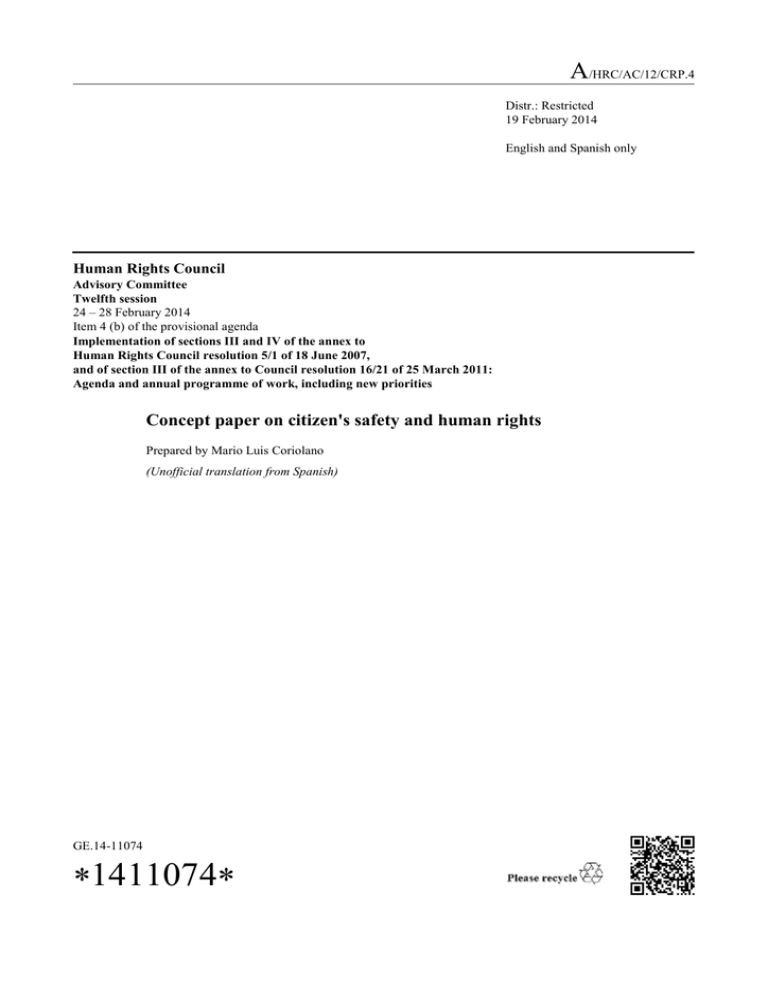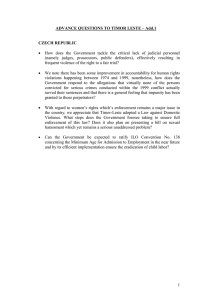A Human Rights Council
advertisement

A/HRC/AC/12/CRP.4 Distr.: Restricted 19 February 2014 English and Spanish only Human Rights Council Advisory Committee Twelfth session 24 – 28 February 2014 Item 4 (b) of the provisional agenda Implementation of sections III and IV of the annex to Human Rights Council resolution 5/1 of 18 June 2007, and of section III of the annex to Council resolution 16/21 of 25 March 2011: Agenda and annual programme of work, including new priorities Concept paper on citizen's safety and human rights Prepared by Mario Luis Coriolano (Unofficial translation from Spanish) GE.14-11074 A/HRC/AC/12/CRP.4 I. Introduction 1. The need for a human rights-based approach to public safety requires firstly accuracy in the terminology itself as there are several terms that are often used as synonyms, such as: public safety, human security, and others, that could be clarified if we further expatiate on this thematic issue. 2. The use of words such as “citizens” or “democratic” does neither leave out the problem of immigrants nor that of countries which do not apply the forms of government in which, through electoral systems, the people elect their rulers. II. Social and institutional violence 3. The world’s reality of growing social and institutional violence requires new ways of thinking and acting, and a new alternative model focusing on human rights is precisely one of the possible ways to break this vicious circle of increasing social and institutional violence. 4. The social violence and its structural (economic, political and institutional) and cultural causes, which sharpens the tension between inclusion and social exclusion – particularly of the most vulnerable, i.e. people who have no access to formal employment, with incomplete educational paths, restrictions to their access to health, housing, etc. – calls for preventive public policies that are comprehensive and built on civil and political rights as well as economic, social and cultural rights. (a) Institutional violence linked to public safety comes from the police (corrupt and violent): police brutality governed by selectivity towards the most vulnerable affects even more the young and the poor, and is based, inter alia, on racist criteria, which overcriminalizes them and thereafter deprives them of any protection. As such selectivity gives rise to over-criminalization firstly and then to absence of protection at the time of responding to their claim of victimization. (b) Similarly the political, judicial and correctional institutions impact on the increase of the institutional violence with high levels of impunity in front of such abuses of power, arbitrary detention, unreasonable delays in proceedings, with almost zero social rehabilitation rates and nearly 10 million prisoners in the world. Of note is the role of the judiciary with regard to the said over-criminalization and lack of protection check impunity for torture that becomes widespread or systematic. (c) Police, judicial and penitentiary reforms have not taken into account a human rights perspective. On the contrary, they have been inspired by efficiency criteria that have marred the police, the judiciary and the correctional services, which are immersed in a deep functional and legitimacy crisis when confronted with the issue of humanity. 5. The pairing of crime prevention and criminal justice should be reviewed, as this generates conceptual confusions with strategic impact on actors who should lead the design, implementation and evaluation of public policies at the local, regional and international levels. III. Alternative human rights-based model 6. I would like to reiterate that this increase of social and institutional violence calls for a study of an alternative human rights-based model to replace the current one. This 2 A/HRC/AC/12/CRP.4 comprehensive model should take into account the different experiences constituting good practices, namely: policies of fair and safe cities; those that motivate local governments to have greater impact and responsibility in this issue; and the valuable records of research and subsequent reports published jointly by the OHCHR and the Inter-American Commission on Human Rights at the initiative of civil society organizations, with an emphasis on civil and political rights in the year 2009. 7. A considerable number of international norms and recommendations of treaty bodies and Special procedures of the Human Rights Council remain unimplemented because of the public policies and the functioning of the institutions concerned – the police, the judiciary and the penitentiary system - have neglected or disregarded human rights. 3
